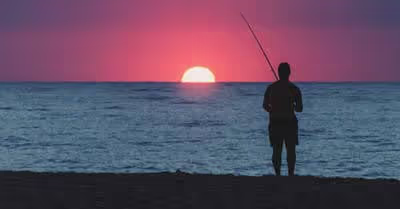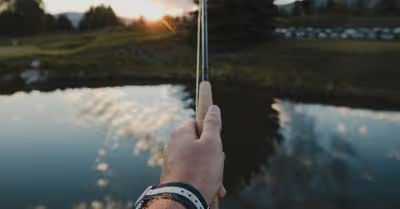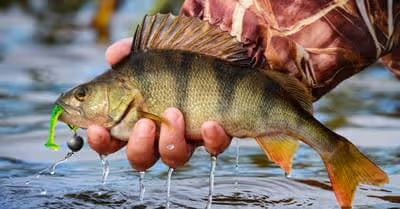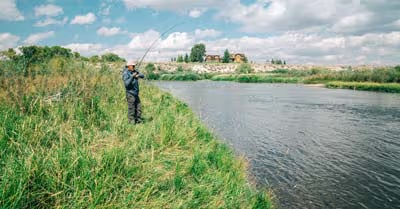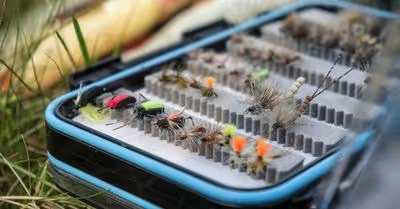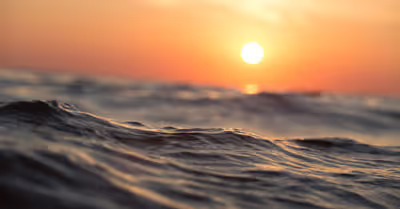Table of Contents
Inshore Fishing Defined
Inshore refers to your distance from land. While technically offshore, inshore fishing is when you’re located relatively close to land. Usually, this water is also quite shallow and not considered deep sea fishing.
Inshore fishing usually takes place no more than five miles offshore. This type of fishing, depending on the location, usually doesn’t require a large boat or expensive equipment. Inshore fishing is a low-cost way to enjoy saltwater fishing without the risks or requirements of an extensive fishing trip.
Inshore Fishing Vs Nearshore Fishing
How does inshore fishing differ from nearshore fishing? By the way we defined inshore fishing, it seems like “nearshore” would be a more accurate way to describe it. But in actuality, nearshore fishing takes place much further out on the water than inshore fishing.
Nearshore fishing takes place up to 30 miles offshore. At these distances, you can catch just about anything that exists in your region of the ocean—including massive prized game fish like swordfish and sharks.
Nearshore fishing isn’t necessarily defined by a specific distance. Instead, it describes the type of conditions encountered and the type of fish you can catch. But nearshore fishing is a universally more cost and time-intensive activity than inshore fishing, and it’s reserved for serious fishermen with the necessary experience and equipment.
It’s best to start with inshore fishing before buying a big boat or going too far offshore. This will allow you to gain the necessary practical experience and to get comfortable in an environment where you may encounter large and powerful fish. Plus, you’ll get to save some time and money in the process and spend more time on the water doing what you love.
Benefits of Inshore Fishing
Inshore fishing is a low-stress activity with a relatively low barrier-to-entry. Generally speaking, you can get away with using less expensive equipment due to the decreased size of the fish. Additionally, inshore fishing doesn’t require an expensive fishing boat—you can use a much smaller boat and be just fine.
Inshore fishing is also more convenient, as it doesn’t take as long to set up, get out on the water, and get back. You can spend the morning or afternoon fishing and be back in time for a meal—hopefully, one that you caught yourself.
Inshore fishing is generally less seasonally affected than nearshore fishing. Many of the game fish you can catch don’t have strict migratory schedules, and you’re more likely to go home with something worthwhile in shallower waters. Additionally, shallow waters are home to a more dense marine environment—which means there are more fish in a given area to catch.
Inshore fishing is a great activity for beginners, especially those who’ve only fished in freshwater or from land. There are fewer hazards, and less expertise is necessary to have a good time. Inshore fishing is fun for the whole family too, and it’s a much more pleasant experience for less interested passengers.
Do You Need a Boat for Inshore Fishing?
Technically, you’ll need to be on a boat to go inshore fishing—but you don’t have to own it. Thanks to the reduced distances involved, you can charter an inshore fishing boat at an affordable price instead of buying one for yourself. If you own a boat, you’ll enjoy reduced fuel and maintenance costs.
What Kind of Boat Do You Need for Inshore Fishing?
You can use lots of different boats for inshore fishing. After all, you’re not far out at sea—and so your boat options are flexible. The most popular kind of boat used for inshore fishing is the classic fiberglass console fishing boat. These robust open boats are powered by one or two medium-sized outboard motors and are usually around 20 feet in length.
Outboard fishing consoles are popular because they’re easy to handle, relatively inexpensive to own and operate, and tough enough to blast through an occasional choppy afternoon. What they lack in creature comforts, they make up for the inconvenience. One of these little boats can easily take four adults on a day-long fishing trip, but overnight excursions are less practical.
Some people use Sport Fisher boats for inshore fishing. These larger vessels, which are usually powered by twin inboard diesel engines, are suitable for much more rigorous offshore activities. With an average length of about 40 feet, these fishing boats have all the accommodations required for a multi-day fishing trip.
The primary disadvantage to inshore fishing on a large boat is draft and maneuverability. Many of the best inshore fishing spots are shallow and can become dangerous during low tide. Additionally, your proximity to the shore can become a problem when your boat is too big to react quickly.
Inshore Fish Species
Fish species vary widely by climate, location, water depth, and even the time of day. However, there are a few fish you can find in many locations when inshore fishing. Here’s a quick breakdown of fish species you can catch by region.
Pacific Northwest
The Pacific Northwest is a popular destination for fishing, though the rocky coastline can be somewhat inhospitable for inshore fishing. However, those who do venture out have access to some excellent local fish species. Some of the most common include walleye, Pacific cod, surf smelt, dogfish sharks, Pacific herring, some species of salmon, and the prized massive halibut.
You may also run into coastal cutthroat trout, but they’re catch-and-release in most parts of the Pacific Northwest.
West Coast
Further south in California, there are dozens of fish species and a much longer comfortable fishing season. Southern California is a good environment for inshore fishing, and the activity is extremely popular there.
Some of the most common inshore species in California include several species of rays, sharks, sea bass, perches, croakers, flatfish, rockfish, and enormous west coast tunas. Inshore fishing on the West Coast is a good bet year-round, and there’s always a huge variety of game fish to catch.
Gulf of Mexico
The Gulf of Mexico is one of the most popular inshore fishing regions in the world. The region is extremely biodiverse, and there’s an almost unlimited amount of locations to fish. Due to the sport’s popularity in the region, you probably won’t be the only small boat out on the water—but the soft coastline and shallow waters make the Gulf an excellent and easy inshore fishing destination.
Inshore fishing species vary wildly by location. That said, the most popular catches on the Gulf are Spanish Mackerel, Sailfish, Wahoo, various species of sharks, King Mackerel, eel, barracuda, redfish, flounder, and spotted sea trout. Just be sure to watch out for jellyfish—it’s a more common annoyance than you may have predicted.
Eastern Florida Coast
Inshore fishing is so popular in Florida that the state gets its own category. Thanks to the geography of the state, inshore fishing is an easy and safe activity along most of its extensive coastline. Many of the fish you’ll encounter off the coast of Florida are found in the Gulf as well, such as tarpon, Spanish mackerel, and redfish.
Other common Florida inshore species include sand perch, sheepshead, snook, southern kingfish, gulf kingfish, anchovy, pigfish, and sardines. You can also catch plenty of eel, crabs, and lobster.
East Coast
Further north, there are still plenty of opportunities for inshore fishing. In states like New Jersey and Massachusetts, inshore species include massive white marlin, blue marlin, cod, bluefish, and prized swordfish. Sea bass is also common, along with ling, porgy, bonito, and some species of mackerel.
Recent Articles



